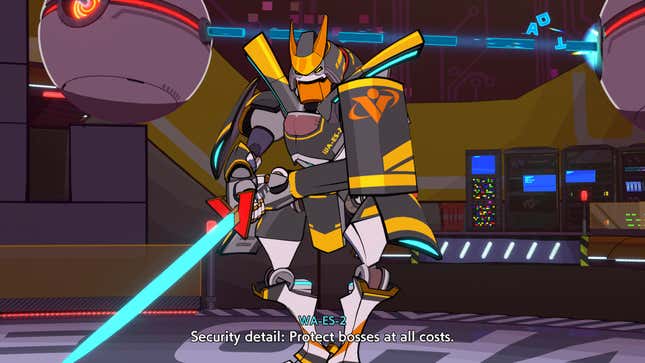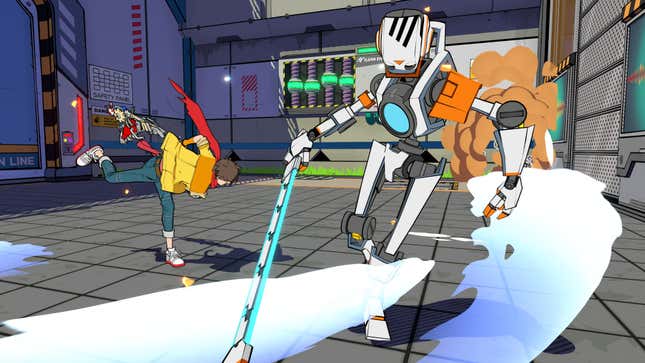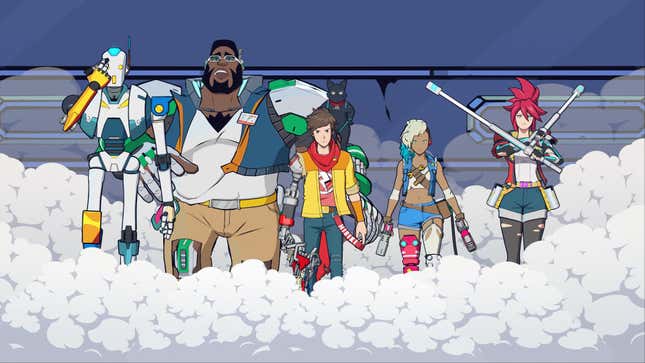There’s a scene late in Hi-Fi Rush, the rhythm action game by the now-defunct Tango Gameworks, in which protagonist Chai explores a museum dedicated to the antagonistic, oppressive megacorp Vandelay Technologies. In it, the corporation tells a sanitized version of its own history, one that glosses over the impact of its founder and how she was forced out to protect exploitative corporate interests. To say that Hi-Fi Rush hits a bit harder a year after its launch in 2023 is an understatement.
We never published a review of Hi-Fi Rush last year, though I did write some impressions of the first few hours. Perhaps that was for the best, as revisiting the game after the tragic, senseless shuttering of Tango Gameworks has made everything special about it shine brighter than ever. Where once we would praise it as an extremely charming, innovative passion project from a big studio, we now appreciate it just as much for the truth of its themes. Watching a ragtag group of abused employees, estranged members of a family business, and an idiot with a heart of gold beat the shit out of a corrupt CEO was cathartic when Hi-Fi Rush launched. Now, though, it feels like something more: the final word from a studio that wanted to be more than another cog in the machine.

Hi-Fi Rush is an exceptional blend of rhythm and action
On top of becoming a retroactive statement piece, Hi-Fi Rush still whips as a video game. I’d forgotten how good Hi-Fi Rush felt to play after being gone for so long, but goddamn, I love how my controller dances when I play it. Tango Gameworks marries character action with rhythm mechanics in a holistic way while remaining accommodating even to those who can’t clap on the beat at a concert.
Chai is a rockstar wannabe with a disabled arm who goes to Vandelay in search of a robotic replacement to help him play guitar. Thanks to a freak accident, he ends up with his legally distinct not-iPod embedded in his chest and is deemed a “defect” by the company. They send their overworked robots after him, but like everything else around him, they are affected by Chai’s new musical heartbeat.
Every swing of your guitar-like sword lands on the beat of the music playing in the background of each stage. You get bonus dodges when you dash on the beat. Your enemies strike in time with the music, so you know when to dodge, parry, or jump if you keep count. More than most character action games like Devil May Cry or Bayonetta, Hi-Fi Rush makes it so easy for me to get lost in the action because my musical sensibilities take over. I stopped worrying about timing combos with precision because my fingers got into the groove of whatever song was playing.

Some of those rhythm dressings can get frustrating. There are segments in which the action stops as enemies lock you into a memorization-based parry pattern to deal a final blow. The rigidness of these bits feels so antithetical to the expressive play of most of Hi-Fi Rush’s action that I dreaded every time a powerful enemy showed up because I knew I’d have to deal with the odd, often imprecise patterns. Ironically, when Hi-Fi Rush makes a harder pivot into being a rhythm game over an action game imbued with rhythm elements, it grinds against its own joy.
When Hi-Fi Rush isn’t restricting you, it is a sublime, instinctual action game in which you lose yourself to the rhythm. I’m the kind of person who finds myself stepping to the rhythm of the music in my headphones as I walk; thus, I remember much of Chai’s journey as choreographed dances that could be written out, beat for beat, onto a piece of sheet music. It’s like moshing through a battlefield, but the people in the pit with me are corporate overlords who only view their robotic workers, human test subjects, and even their colleagues as numbers on a spreadsheet.
Hi-Fi Rush’s anti-corporate themes are more potent than ever
Each level in Hi-Fi Rush takes place in some part of a company campus, but they’re covered in hazards Chai has to jump, dash, and dance through to save himself from Vandelay’s brainwashing. But those erupting volcanoes, electrified platforms, and bottomless chasms are just the working environment that Vandelay’s employees must operate in to survive. And those dangers are only half the threat, as an employee’s stability and legacy within the company, no matter how hardworking or accomplished they might be, is only guaranteed for Vandelay’s top brass.

The unforgiving gristmill of working for Vandelay is often portrayed through tongue-in-cheek text logs or banter from robotic employees Chai passes by, and it’s not always subtle. Bosses are willing to drain budgets and resources to try and detain Chai, their perceived “mistake,” while others are more than willing to put their workers in our hero’s line of fire if it means correcting a problem of their own making. It’s only after Chai has walked through the deathtrap that is Vanderlay’s campus that he can take out the source of all this pain and suffering: the bosses at the helm.
Hi-Fi Rush was in development long before Bethesda and its studios were acquired by Microsoft and the Xbox company started tearing things down, but it has become prophetic for Tango Gameworks’ fate. It stars a cast of workers who endure nothing but anguish from corporate fuckery while trying to make a difference. Their ending is happier than the studio that made their story, but Hi-Fi Rush still exists as a declaration of its creators’ values as it succumbs to the same corporate rot it sought to fight. But one lost battle is not a lost war. Movements like the one Chai and his friends spearhead take different forms as time passes. The artists will pick up their pens, the designers will open a new doc, and the musicians will compose new songs once more. If Hi-Fi Rush proves anything, it’s that the fight for a better future, one in which we are free from corporate clutches, is only possible when we fight together. I hope it’s remembered most for that.






